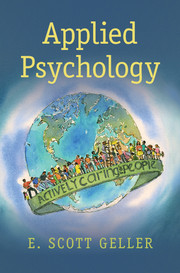Book contents
- Frontmatter
- Dedication
- Contents
- Foreword
- Preface: The Actively Caring for People (AC4P) Movement
- About the Authors
- Acknowledgments
- INTRODUCTION TO PART I EVIDENCE-BASED PRINCIPLES OF AC4P
- INTRODUCTION TO PART II APPLICATIONS OF AC4P PRINCIPLES
- 9 Actively Caring for Occupational Safety
- 10 Cultivating an AC4P Culture in Organizations
- 11 Actively Caring for Traffic Safety
- 12 Actively Caring to Prevent Alcohol Abuse
- 13 Actively Caring for Obesity
- 14 Actively Caring for Patient-Centered Healthcare
- 15 Actively Caring for Our Children
- 16 Actively Caring for Preschoolers
- 17 Actively Caring Coaching for Young Athletes
- 18 Actively Caring for Higher Education
- 19 Actively Caring for Mother Earth
- 20 The AC4P Power of Pets
- Epilogue: Where Do We Go from Here?
- Subject and Name Index
- References
16 - Actively Caring for Preschoolers
from INTRODUCTION TO PART II - APPLICATIONS OF AC4P PRINCIPLES
Published online by Cambridge University Press: 05 March 2016
- Frontmatter
- Dedication
- Contents
- Foreword
- Preface: The Actively Caring for People (AC4P) Movement
- About the Authors
- Acknowledgments
- INTRODUCTION TO PART I EVIDENCE-BASED PRINCIPLES OF AC4P
- INTRODUCTION TO PART II APPLICATIONS OF AC4P PRINCIPLES
- 9 Actively Caring for Occupational Safety
- 10 Cultivating an AC4P Culture in Organizations
- 11 Actively Caring for Traffic Safety
- 12 Actively Caring to Prevent Alcohol Abuse
- 13 Actively Caring for Obesity
- 14 Actively Caring for Patient-Centered Healthcare
- 15 Actively Caring for Our Children
- 16 Actively Caring for Preschoolers
- 17 Actively Caring Coaching for Young Athletes
- 18 Actively Caring for Higher Education
- 19 Actively Caring for Mother Earth
- 20 The AC4P Power of Pets
- Epilogue: Where Do We Go from Here?
- Subject and Name Index
- References
Summary
One looks back with appreciation to the brilliant teachers, but with gratitude to those who touched our human feelings. The curriculum is so much necessary raw material, but warmth is the vital element for the growing plant and for the soul of the child.
– Carl JungActively caring for people (AC4P) of course includes children we commonly refer to as “preschoolers,” ages 3–5 years. How do we best launch these children for lifelong success? Kindergarten can be exciting, yet perhaps overwhelming or possibly scary – especially today, as many scholars cite the academic rigor of kindergarten. The mission is no longer simply learning to play and relate with others. Now kindergarten children must master certain academic requirements.
More children are engaged in preschool activities today, perhaps due to increased kindergarten entry requirements. Currently, no federal or state mandates for preschool exist, but approximately half of U.S. children aged 3–4 are enrolled in some sort of preschool/daycare experience. Critical questions arise: How important is the preschool experience, and what characteristics define an effective preschool program?
THE IMPORTANCE OF PRESCHOOL
This chapter explores the AC4P behaviors of teachers that can promote early learning in preschool settings. We discuss how teachers can learn to create an AC4P culture in their classrooms to effectively promote early childhood development. Consistent with the theme of this book, information contained in this chapter clearly aligns with the basic principles of the AC4P Movement introduced in Chapter 2.
Children of preschool age differ considerably in their readiness or ability to learn to read and do math. These skills are highly predictive of later educational success. With regard to reading, for example, early elementary years appear to be critical for learning basic reading skills. In later grades, elementary school teachers transition from teaching students how to read to expecting students to acquire knowledge and learn through reading.
Perhaps you recall how your fifth- and-sixth-grade teachers began asking you to read longer sections of textbooks as homework and to learn new and exciting information in domains such as science and history through the process of reading. Imagine that experience had you not yet learned how to read.
- Type
- Chapter
- Information
- Applied PsychologyActively Caring for People, pp. 506 - 534Publisher: Cambridge University PressPrint publication year: 2016



